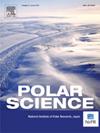New approaches to modeling the critical refreezing length of a Philberth melt probe for ice sheet exploration
Abstract
In recent years, interest in using Philberth melt probes in the exploration of subglacial lakes or extraterrestrial ice-covered planets has significantly increased. Consequently, several Philberth melt probes have been developed or are currently being developed. The critical refreezing length is a key parameter in determining the distribution of the lateral heater of the Philberth melt probe. In this study, two new approaches for calculating the critical refreezing length were proposed. Approach I was established based on the refreezing of a virtual borehole, whereas approach II was developed in the COMSOL Multiphysics 5.6a software by modeling the phase change of water and ice in the non-heated section of the Philberth melt probe. The two novel approaches were validated with the field test results of RECoverable Autonomous Sonde (RECAS) in Antarctica. The difference between the two approaches and the existing calculation methods was less than 32% and approach I presented a smaller critical refreezing length. The thermal head efficiency and ice temperature had significant influence on the critical refreezing length. Usually, the critical refreezing length increased with an increase in the thermal-head diameter, penetration rate, and ice temperature, whereas it decreased with an increase in the thermal head efficiency.

 求助内容:
求助内容: 应助结果提醒方式:
应助结果提醒方式:


